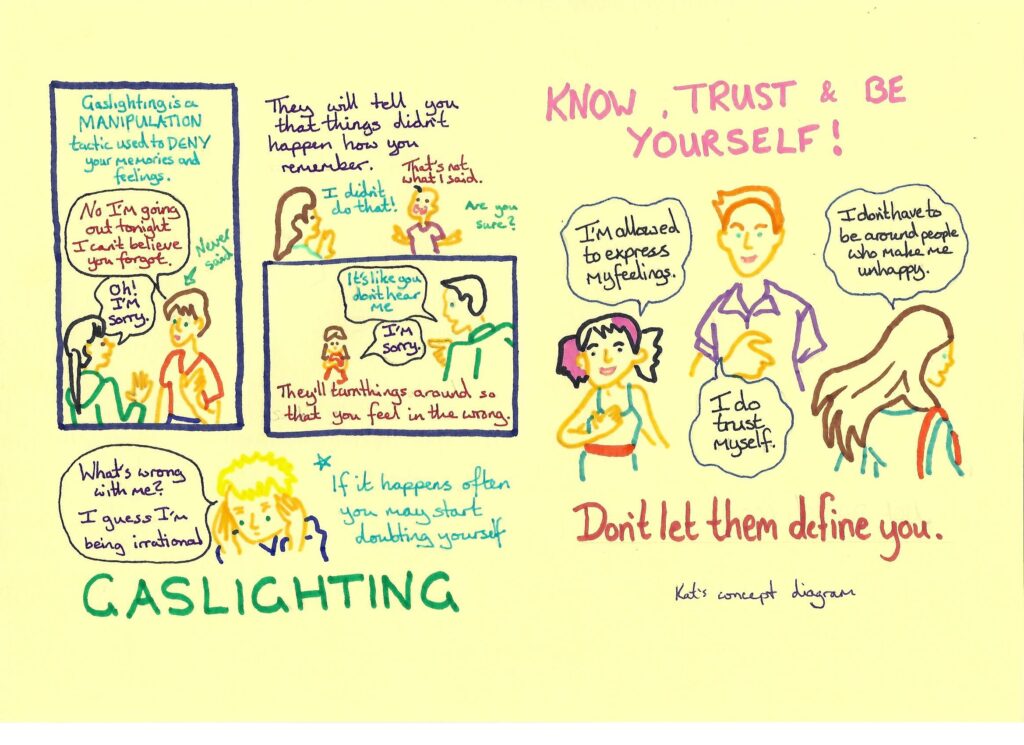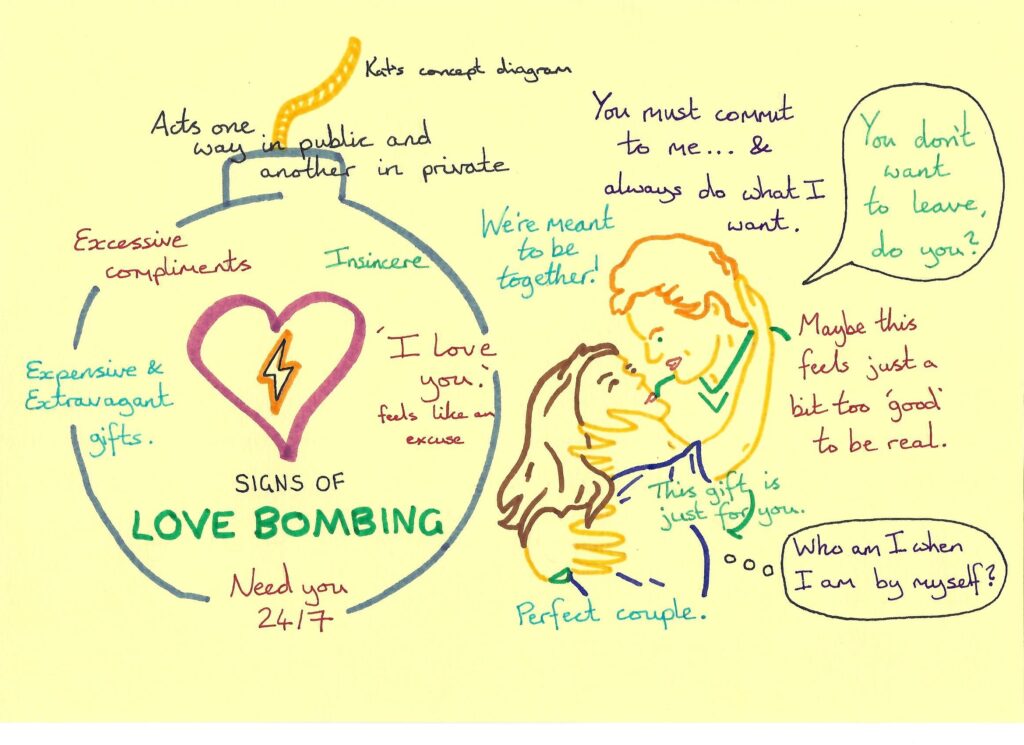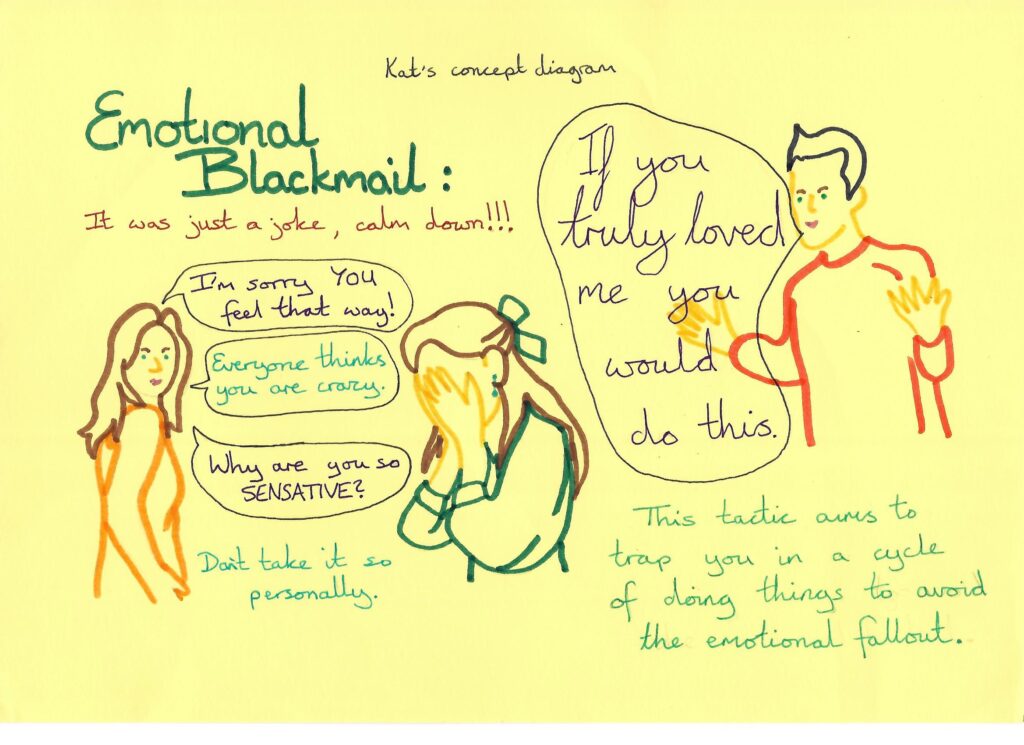5 Key aspects to consider
We have chosen 5 areas to look at in a little more depth linked to this aspect of the curriculum. Many of them have links to other modules you may have already done or be doing later in the sequence. This is because most areas of Personal, Social and Health Education are intrinsically interwoven with each other and sociology and human behaviour more generally.
Recognising and Managing Negative Influence, Manipulation, and Persuasion (Online and Offline)
Ever been guilt-tripped into doing something? Or maybe someone’s used a sob story to manipulate your feelings? It happens to the best of us! Here we explore how to spot when someone is trying to control you or others and how to keep your cool in these situations. This isn’t just about random people – manipulation can come from friends, classmates, or even online influencers.
Spotting the Signs of Manipulation
Manipulators often use tactics like love bombing, gaslighting, and emotional blackmail to control or influence others. Being able to identify these behaviours can help you recognise when someone is attempting to manipulate you.



Understanding these manipulation tactics is crucial for protecting yourself. If you notice someone’s behaviour aligns with these patterns, it’s important to set boundaries or seek support.
Tuning Out the Noise: Avoiding Online Scams and Social Media Pressure
The online world is rife with manipulation and negative influence. Scammers, marketers, and even social media influencers use various psychological tactics to influence your behaviour, often without you realising it.
Online scams often prey on people’s trust, fear, or desire for quick rewards. Phishing scams, for example, might appear as urgent emails asking you to verify your personal information, while clickbait uses sensational headlines to lure you into engaging with misleading or low-quality content. To protect yourself, always verify the credibility of sources, avoid clicking on suspicious links, and be cautious about sharing personal information online.
Social media also pressures people to conform to certain standards of beauty, success, or lifestyle. Influencers often portray perfect, curated versions of their lives, creating unrealistic comparisons. The constant exposure to these idealised images can lead to feelings of inadequacy, self-doubt, or a need to conform. Tuning out this noise requires mindfulness—remember that what you see online is often exaggerated or filtered. Take breaks from social media, and remind yourself that your worth is not defined by likes, followers, or material success.
Standing Your Ground: The Power of Saying “No”
A major component of resisting manipulation and negative influence is learning how to say “no” confidently and without guilt. Manipulators often thrive on exploiting the kindness or insecurity of others. They rely on the fact that many people feel uncomfortable with confrontation or worried about being perceived as rude or selfish.
However, setting boundaries is an essential part of protecting yourself from manipulation. Saying “no” when you’re uncomfortable or don’t want to do something is a powerful way to maintain control over your decisions. It’s important to understand that your time, energy, and feelings are valuable, and you have the right to prioritise them.
Here are a few tips for saying “no” effectively:
- Be clear and assertive: Avoid being vague. For example, instead of saying, “Maybe later,” say, “I’m not comfortable with that,” or “I’m going to pass on this.”
- Avoid over-explaining: You don’t owe anyone a lengthy justification for your decision. A simple, “No, thank you” is enough.
- Practice self-compassion: Remember that saying no doesn’t make you a bad person. In fact, it shows that you respect yourself and your boundaries, which ultimately leads to healthier relationships.
The ability to say no without feeling bad about it stems from knowing your worth and trusting your instincts. By prioritising your needs and comfort, you reduce the likelihood of being manipulated or pressured into situations that aren’t in your best interest.
Recognising and Managing Different Forms of Abuse, Support Systems, and Exit Strategies for Unhealthy Relationships
Not all abuse leaves visible marks. Emotional abuse, manipulation, and controlling behaviour can be harder to spot but just as harmful. Recognize different forms of abuse – whether it’s emotional, physical, or financial – and knowing how to get out safely is important.
Abuse in relationships can take many forms, and recognizing the warning signs is the first step toward seeking help and protecting yourself. Abuse doesn’t always start with physical violence—it can be subtle, emotional, or psychological, gradually escalating over time. Understanding what abuse looks like, where to turn for support, and how to safely leave a toxic relationship are all critical elements in ensuring your well-being.
Where to Turn for Support
If you recognise these signs of abuse, reaching out for support is crucial. You don’t have to face an abusive relationship alone, and there are many resources available to help you. Here are a few places to start:
- Hotlines: Domestic violence. National Bullying or other helplines can provide confidential, 24/7 support. Trained professionals can offer advice, resources, and help you create a safety plan. Some examples: National Bullying Helpline, Refuge, Childline, Samaritans. You will find the links included at the end of this section.
- Trusted Adults: If you’re unsure where to turn, confide in a trusted adult—this could be a family member, teacher, or counsellor. Sharing your situation with someone who cares about you can help you feel less isolated and provide guidance on what steps to take next.
- Support Groups: Many communities and online platforms offer support groups for individuals in abusive relationships. Connecting with others who have gone through similar experiences can help you feel understood, validated, and empowered to make the changes you need.
Creating an Exit Plan
Leaving an abusive relationship is not always straightforward. It can be dangerous, especially if your abuser becomes aware of your plans to leave. That’s why it’s essential to create an exit plan that prioritises your safety and allows you to leave without setting off alarm bells.
Here are some key steps to follow when creating a safe exit plan, click them to learn more details:
Gather important documents and money:
Quietly collect important documents like your ID, birth certificate, passport, and any legal or financial papers. You may also want to set aside money in a separate account that your partner cannot access.
Plan where to go
Identify a safe place where you can go when you leave. This could be a friend’s or family member’s house, a domestic violence shelter, or another secure location that your partner is unaware of. Ensure that you have a way to get there quickly if needed.
Keep a record of the abuse
If possible, document instances of abuse by taking photos of injuries, saving threatening messages, or writing down details of abusive incidents. This can be helpful if you need legal protection or want to press charges later.
Use a trusted support network
Inform a trusted friend, family member, or support group about your plans to leave. Let them know when and how you intend to leave so that someone can check in on you during this critical time.
Leave when it’s safe
Timing is everything. Choose a moment when your partner is not around or preoccupied to pack your things and leave. Avoid announcing your departure, as this can provoke a dangerous reaction from the abuser.
Everyone deserves to be in a relationship built on respect, kindness, and mutual support. If your relationship feels more like a battleground of control, manipulation, or fear, it’s important to trust your instincts and seek help. By recognising the signs of abuse, turning to available support systems, and creating a safe exit plan, you can protect yourself and move toward a healthier, happier life. Remember, you are not alone—help is always available, and there is a path out of even the darkest situations.
Recognising Forced Marriage and ‘Honour’ Based Violence: How to Get Help
This can be a tricky and sensitive topic, but it’s important. Forced marriages and ‘honour’ based violence are serious human rights violations. If you, or someone you know, is at risk, there are ways to get help. No one should be forced into a marriage against their will, and violence is never the answer to family problems or societal issues.
Arranged vs. Forced Marriages
An arranged marriage is when families help two people meet and facilitate a marriage, but both individuals consent to the union. They have the freedom to accept or reject the proposal. It’s important to understand that arranged marriages are based on mutual agreement and respect for individual choice.
In contrast, a forced marriage happens when one or both individuals are coerced into marrying against their will. There is no consent, and pressure can come in many forms, such as emotional manipulation, threats, or physical violence. This is a violation of human rights and is illegal in the UK regardless of whether the individuals involved are minors or have reached their legal majority.
Honour-Based Violence
Honour-based violence occurs when individuals are harmed because their behaviour is perceived to have brought shame or dishonour to their family or community. This can happen if someone refuses a forced marriage, seeks independence, or is seen as defying cultural or family expectations. Honour-based violence can involve threats, pressure, and sometimes physical violence, often committed by close family members.
Where to Find Help
If you or someone you know is at risk, it’s crucial to seek help immediately. The police are trained to handle cases of forced marriage and honour-based violence. You can also reach out to local organisations and helplines that specialise in protecting individuals from these situations. Remember, seeking help is a brave and necessary step—there is no shame in prioritising your safety or that of a loved one.
There are helplines for forced marriage and honour-based violence, though do understand that if you or someone else is at immediate risk then you should call 999, if in the UK, or the appropriate emergency service if abroad.
Important: If you call 999 in a situation where you cannot speak then listening to instructions and pressing 55 once they have picked up will let call handlers know to track the signal and send help immediately. It is easy to remember: if you are in a Silent Situation dial 55.
Strategies for De-escalating and Exiting Aggressive Social Situations
Arguments, fights, and heated moments happen, but knowing how to defuse these situations can keep things from getting out of hand. This section focuses on staying calm when things get tense and finding an exit before things escalate. Conflicts are a natural part of life but knowing how to recognize when a situation is escalating, how to de-escalate it, and how to exit safely can help prevent physical or emotional harm. Whether you’re in a heated argument, dealing with an aggressive stranger, or facing a tense situation with friends or family, your safety and well-being should always be the top priority. Here’s how to manage these scenarios effectively:
Recognize the Signs: Know When Things Are About to Go South
The first step in managing an aggressive situation is recognizing when things are starting to escalate. Pay attention to both verbal and non-verbal cues:
- Verbal cues: Raised voices, insults, threats, or personal attacks are clear signs that a conversation is no longer productive and may be heading toward conflict.
- Non-verbal cues: Body language can reveal a lot. If someone starts clenching their fists, standing too close, or using aggressive gestures, it’s a sign that they’re losing control.
- Gut feeling: Trust your instincts. If something feels off or unsafe, it probably is. Often, your body will pick up on tension before your mind does, so pay attention to feelings of unease or anxiety.
Recognizing these signs early allows you to take action before the situation spirals out of control.
De-escalate: Stay Calm, Use Humour or Distraction, or Simply Walk Away
Once you’ve recognized that things are heading in the wrong direction, the next step is to de-escalate. Here are some tactics you can use:
- Stay calm: If you raise your voice or match the other person’s aggression, it will likely escalate the situation further. Take deep breaths, speak slowly, and remain composed.
- Use humour: Sometimes, a light joke or playful comment can diffuse tension and break the cycle of anger. However, use humour carefully, as it might backfire if the other person feels you’re not taking them seriously.
- Distraction: Changing the subject can redirect attention away from the conflict. For example, you might shift the conversation to a neutral topic or suggest taking a break.
- Active listening: Showing empathy and validating the other person’s feelings can sometimes calm them down. Phrases like “I understand why you’re upset” or “Let’s figure this out together” can make the other person feel heard and respected.
Walk away: If none of the above tactics work, don’t be afraid to remove yourself from the situation. Walking away is a simple but effective way to avoid unnecessary conflict. It doesn’t mean you’re giving up; it means you’re choosing to prioritise your safety and peace of mind.
Safety First
At the end of the day, your safety and well-being are more important than “winning” an argument or confrontation. Recognizing the early signs of escalation, using de-escalation techniques, and knowing when to walk away can save you from harmful encounters. Not every battle is worth fighting, and knowing when to disengage is a sign of strength, not weakness.
Task Three – Take a Moment to Reflect
To better understand these points, take a moment to reflect on a recent argument or tense situation you’ve been involved in. Write a brief account of what happened and answer the following questions:
- What were the early signs that things were escalating?
- How did you respond at the moment? Were there any tactics you used to de-escalate the situation?
- If you could go back, how might you have exited the situation more safely or effectively?
- Did the conflict resolve, and how did it affect your relationship with the other person?
By reflecting on a personal experience, you’ll gain insight into how these strategies can be applied in real life and become better prepared for future situations.
Celebrating Cultural Diversity and Challenging Prejudice and Discrimination
The world is a colourful mix of cultures, beliefs, and traditions. But sometimes, people don’t respect these differences. We have already touched on how it is important to promote inclusion and celebrate diversity while standing up against discrimination, but let’s look a little closer.
Embracing Different Cultures Enriches Everyone’s Life: Diversity is about more than just recognizing differences in race, culture, gender, and beliefs. It’s about understanding that these differences enrich our lives and make our communities stronger. When we embrace diversity, we open ourselves up to new ideas, perspectives, and experiences that we may not have encountered otherwise. Whether it’s learning about different cultural traditions, hearing varied viewpoints in a discussion, or understanding how people from different backgrounds approach challenges, diversity broadens our worldview.
By celebrating diversity, we also develop empathy and appreciation for the uniqueness of others. This helps break down stereotypes and misconceptions, which are often the root causes of bullying and discrimination. Instead of fearing or excluding those who are different, we learn to see the value they bring to our communities, fostering respect and understanding.
Challenging Prejudice: How to Respectfully Call Out Discrimination
Prejudice and discrimination happen when people are judged unfairly based on their race, gender, religion, or other characteristics. When we witness discrimination, it’s important to call it out, but we must do so in a way that promotes understanding rather than conflict. Here are a few ways to challenge prejudice respectfully:
- Stay calm and composed: If you confront someone with anger or hostility, it may escalate the situation. Try to stay calm and approach the situation with a desire to educate, not attack.
- Ask questions: Sometimes, people don’t realise they’re being prejudiced. Asking questions like “Why do you think that?” or “How would you feel if someone said that to you?” can help them reflect on their behaviour.
- Use “I” statements: Instead of accusing someone directly, frame your response in a way that expresses your feelings. For example, “I feel uncomfortable when you say things like that because I believe everyone deserves respect.”
By standing up against discrimination in a respectful way, you help create a more inclusive environment while encouraging others to reflect on their actions.
Building an Inclusive Environment: Little Actions You Can Take
Creating an inclusive environment is about making everyone feel valued and respected, regardless of their differences. Even small actions can have a big impact in promoting inclusion and reducing discrimination. Here are a few ways you can help build a more inclusive environment, click on them to reveal more details:
Be welcoming
When new people join your school, workplace, or community, make an effort to welcome them. Something as simple as saying hello, asking them to sit with you at lunch, or introducing them to others can go a long way in making someone feel included.
Be mindful of your language
Avoid using stereotypes, slurs, or making jokes about someone’s background or identity. Words can hurt more than we realise, so it’s important to choose them carefully.
Celebrate differences
Encourage others to share their cultures, traditions, or experiences. By showing interest in what makes people unique, you create a space where everyone feels comfortable being themselves.
Listen actively
When someone shares their experiences, especially those related to discrimination or exclusion, listen without interrupting or dismissing their feelings. Acknowledging their experience shows that you respect and care about their perspective.
Inclusion Isn’t Just a Buzzword – It’s a Mindset!
Inclusion isn’t about doing one thing and then forgetting about it; it’s about consistently practising empathy, respect, and open-mindedness. When we make inclusion a mindset, it becomes a part of how we interact with others every day. This mindset helps to break down the barriers that lead to bullying and discrimination. It encourages us to see everyone as valuable and deserving of respect, which in turn creates a safer, more welcoming environment for all.
Task Four – Design a Campaign
Imagine you’re designing a campaign to promote inclusion and diversity in your school, or community.
Create a poster, infographic, or social media post that showcases what an inclusive environment looks like. Use symbols, quotes, or imagery to convey your message of acceptance and respect.
After finishing your design, write a short explanation about why inclusion is important and how your design reflects a community where everyone feels valued and differences are celebrated.
This activity encourages you to visualise inclusion and think creatively about how to promote it in your everyday life.
Conclusion
Managing negative influences is essential for creating an inclusive society. Negative influences—such as prejudice, stereotypes, and peer pressure—fuel discrimination and division. They shape how people think and behave toward others, often leading to exclusion and harmful actions like bullying. When individuals recognize and manage these negative influences, they become more aware of their own biases and are better equipped to challenge harmful attitudes around them.
By rejecting negative influences, people create space for positive values like empathy, respect, and understanding to flourish. This shift helps break down barriers between different groups, promoting a more inclusive society where diversity is celebrated rather than feared. For instance, when we actively challenge harmful stereotypes or resist the pressure to follow discriminatory norms, we set an example for others and encourage them to do the same. In doing so, we build communities that value each person’s unique identity and foster an environment of belonging for everyone.
Ultimately, managing negative influences empowers us to lead by example, promoting kindness, respect, and inclusivity in all areas of life, from school and work to social interactions.
GIST – Good Ideas for Starting Things
- Writing Personal Pledges: to promote respect and inclusion, such as “I will speak out against bullying,” or “I will make an effort to include everyone in group activities.” Display these pledges in school as a reminder.
- Volunteering or Fundraising for a Cause: to encourage learners to support local organisations that work against bullying, abuse, or discrimination. They could raise money for a helpline, volunteer at a community centre, or run a donation drive for a local charity etc
- Hosting a Discussion Circle: organise a safe space where learners can share their experiences or thoughts about these issues. Discuss strategies for standing up to bullies or creating a more inclusive environment
Want to learn more?
To dig deeper into topics like bullying, manipulation, and healthy relationships, check out these awesome books and websites:
- “Odd Girl Out” by Rachel Simmons – A powerful book on the hidden culture of bullying and aggression among girls.
- “Bullying Beyond the Schoolyard” by Sameer Hinduja and Justin Patchin – A guide to understanding and preventing cyberbullying.
- “The Bully, the Bullied, and the Bystander” by Barbara Coloroso – This book covers the roles involved in bullying and how to handle them.
- This website packed with resources on bullying prevention and how to get help.
- This website with practical strategies for safety and healthy relationships for kids, teens and adults.
National Helplines:
Support is available from many sources online and via phone or text. Here are three charities which provide information or support services in specific situations;
https://www.nationalbullyinghelpline.co.uk/ – This is the main website for the prevention of bullying in the UK. They have a helpful directory of many other places where you can find help and information on the different services available in each local area.
https://refuge.org.uk/ https://www.childline.org.uk/ – Refuge is a charity providing help, care and support for women and children experiencing domestic violence.
https://www.samaritans.org/ – This charitable organisation provides information and free confidential advice and support with big and small issues, from bullying to suicide prevention.
However, always remember that if there is the risk of immediate danger or harm to yourself or someone else, then 999 and the relevant emergency service should be contacted.
